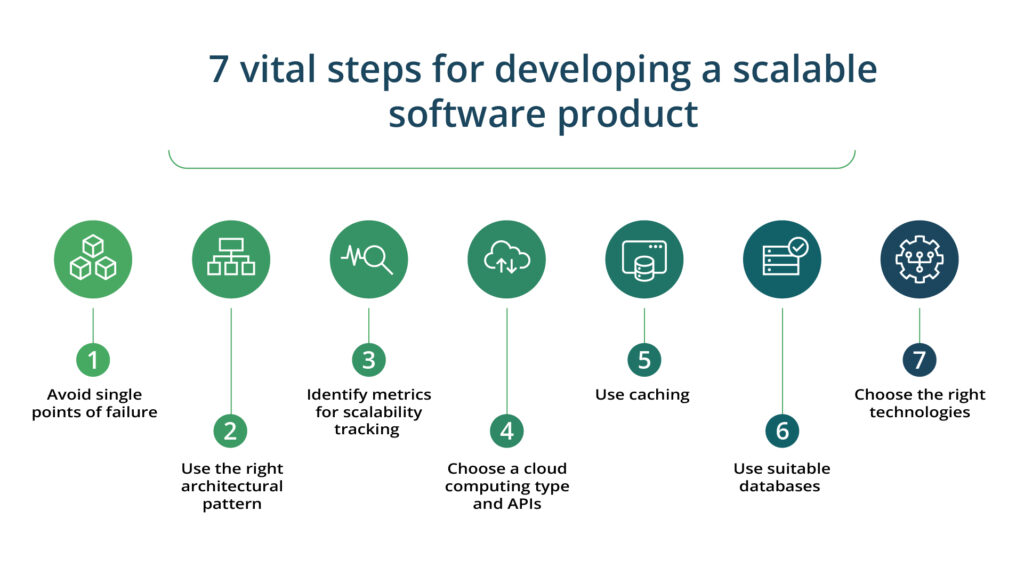
A product’s scalability is defined by its ability to handle increasing user demands and requirements. Essentially, it refers to the software’s capacity to adapt to changing needs, regardless of their magnitude.
Consider any thriving startup as an example. Initially, it may have been designed to cater to a specific number of requests, but as it grows into a bigger enterprise, scaling becomes necessary. Typically, it implies expanding storage, enhancing data transfer, or introducing new features to ensure optimal performance in new market conditions.
Long story short, it entails developing a flexible architecture that can adjust to anticipated demands and unforeseen circumstances.
In this article, we’ll break down the challenges in developing a scalable software product, provide key solutions to meet the increasing demand of your high-load capacity business, observe the common scaling methods, and suggest seven steps to initiate your scalable software development project.
There can be a myriad of reasons why you may want to scale your software product. Below are the five alarming signs indicating that it’s time to scale.
Have you launched a marketing campaign and expect more users to visit your website or mobile application? A scalable system can easily handle the additional workload, increasing the performance of your product.
Adding resource-intensive features that require more Central Processing Units (CPU) or storage is another reason to consider scaling. These features can cause performance issues without scaling, leading to delays or response failures.
Introducing new features and optimizing data usage is another sign that your software needs a flexible architecture allowing fast and successful integration of the improvements.
Bottlenecks in the system indicate an uneven workload distribution, requiring scaling to balance workload and track downstream processes to avoid further bottlenecks.
Memory issues, an unresponsive database, large loads, or poorly configured technologies can cause slow service. Scaling helps spread the workload evenly and identifies architectural weaknesses that need addressing.
Developing a system that can handle growth requires careful consideration of various challenges.
Optimizing the performance of one function may go hand in hand with decreased performance of the other. It’s critical to prioritize consistency, availability, and resilience. It’s crucial to anticipate these performance issues. For example, consider implementing options for immediate updates as well as updates over time.
As the number of users increases, the system must handle higher traffic and usage. One way to achieve this is to expand capacity, giving the software more power and enabling additional features.
However, it’s crucial to be aware of the resources users need to allocate, such as system performance, memory usage, and battery. Finding a balance between these aspects should be at the forefront of any scalability plan.
When scaling up software, more resources and technologies will be needed. This may require creating a new maintenance plan and budget to address potential issues.
You can build your digital product from scratch or use off-the-shelf solutions that are easier to set up and maintain. The former offers greater customization but at a higher cost, while the latter can save time and money using standard solutions.
Vertical and horizontal scaling are the two primary methods of scaling software.
Let’s observe the pros and cons of each method.
This method would require adding more powerful hardware to the system, such as increasing the CPUs or Random-access Memory (RAM) to handle the workload.
Pros: Vertical scaling in the cloud refers to adjusting the size of cloud resources to match the workload instead of buying additional resources. It is commonly referred to as “right-sizing.” Right-sizing is a cost-effective way to manage cloud expenses and can result in significant cost savings when done correctly. By ensuring resources are correctly sized to the workload, costs associated with vertically scaled resources can be reduced.
Cons: There may be certain limitations or higher upfront costs, which could lead to the potential for a single point of failure.
Vertical scaling is suitable when you know the exact number of tasks that the system needs to perform. However, the system may not be flexible enough for rapidly changing markets.
This approach implies distributing the workload evenly among existing servers using a load balancer. By doing so, scaling up and down can be done in a flexible manner, and with the addition of more machines, backup configurations can be established to prevent a single point of failure.
Pros: Horizontal scaling can be achieved without downtime. Another advantage is that it is easier to automate compared to vertical scaling. It positively impacts system performance by limiting the number of requests each instance receives at any given time. Additionally, adding more instances enhances redundancy in case of an outage, even if the system is large.
Cons: In horizontal scaling, an efficiently organized computing infrastructure is necessary. Moreover, the cost of a load balancer can grow with the request volume and the scope of data handled. To ensure optimal outcomes, it’s crucial to align the selected method with the long-term scaling plan and user requirements in advance. In such scenarios, horizontal scaling might be a more appropriate approach to establish adaptable and robust software systems.
Below are seven essential steps for any project involving the development of a scalable software product. Consider using these steps as a starting point for a big scalability initiative.

Step 1. Avoid single points of failure
Single points of failure can cause the entire system to fail, so it’s essential to split the architecture into smaller parts that are independent of each other. One prevalent approach for accomplishing this is through microservices architecture, which offers improved system management.
Step 2. Use the right architectural pattern
Your product’s architectural pattern significantly impacts the scalability solutions available to you. Common patterns include layered (n-tier), event-driven, microservices, micro-kernel, and space-based architectures. The selection of an appropriate architecture pattern hinges on the product and its associated workload.
Step 3. Identify metrics for scalability tracking
In order to monitor and evaluate modifications during the scaling process, it is necessary to establish methods for assessing system performance. It may involve tracking metrics such as CPU and memory usage, network and disk inputs and outputs, latency duration, and other factors. Numerous performance monitoring tools for applications can provide these insights.
Step 4. Choose a cloud computing type and APIs
Opting for cloud computing can simplify and reduce the cost of scaling. Depending on the requirements of your product, you can select either Infrastructure-as-a-Service (IaaS), Platform-as-a-Service (PaaS), or Software-as-a-Service (SaaS).
Step 5. Use caching
Caching can prevent bottlenecks caused by costly or repetitive database queries or page renders. By switching the processing logic first to search the cache rather than the database, you can decrease the workload on the database and accelerate the search process.
Step 6. Use suitable databases
NoSQL databases are better suited for scalability, as they enable data sharing and faster query responses. Conversely, RDBMS or SQL databases are better suited for monolithic applications requiring single-point data access.
Step 7. Choose the right technologies
Selecting technologies that initially facilitate scalability approaches, such as popular libraries, suitable search algorithms, and asynchronous coding that offloads non-critical tasks, is essential for building a scalable product.
Any business should strive to create a scalable software product to meet changing market conditions and growth demands.
In this article, we’ve identified five signs that indicate that it is time for your business to scale, as well as observed key challenges that come with developing a scalable product. Additionally, we’ve explored the two primary scaling methods — vertical and horizontal — and outlined eight essential steps to developing a scalable software product.
By following these steps, businesses can create a software product that caters to their specific needs and adapt to their growth.
Kanda’s team of experts can provide guidance and support throughout the entire scalable software development process, from ideation to deployment. By leveraging Kanda’s expertise in this field, you may rest assured about accelerating your project timelines, reducing development costs, and developing software products that can grow and adapt to your business needs.
Talk to our experts, and let’s jumpstart your scalability efforts today.



